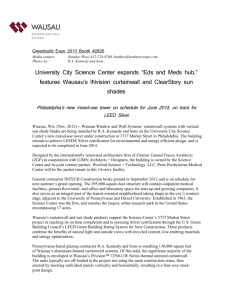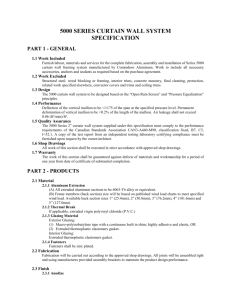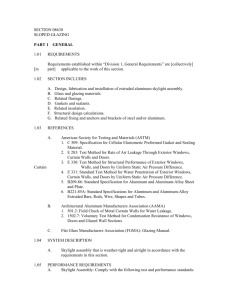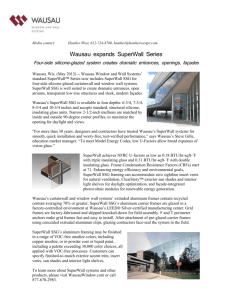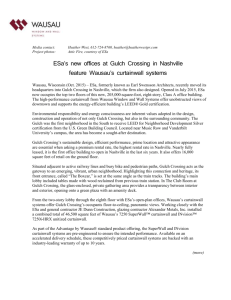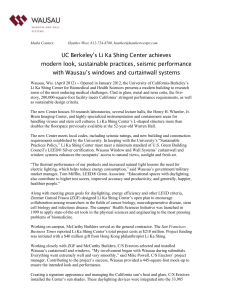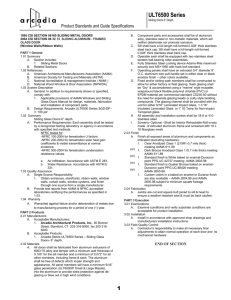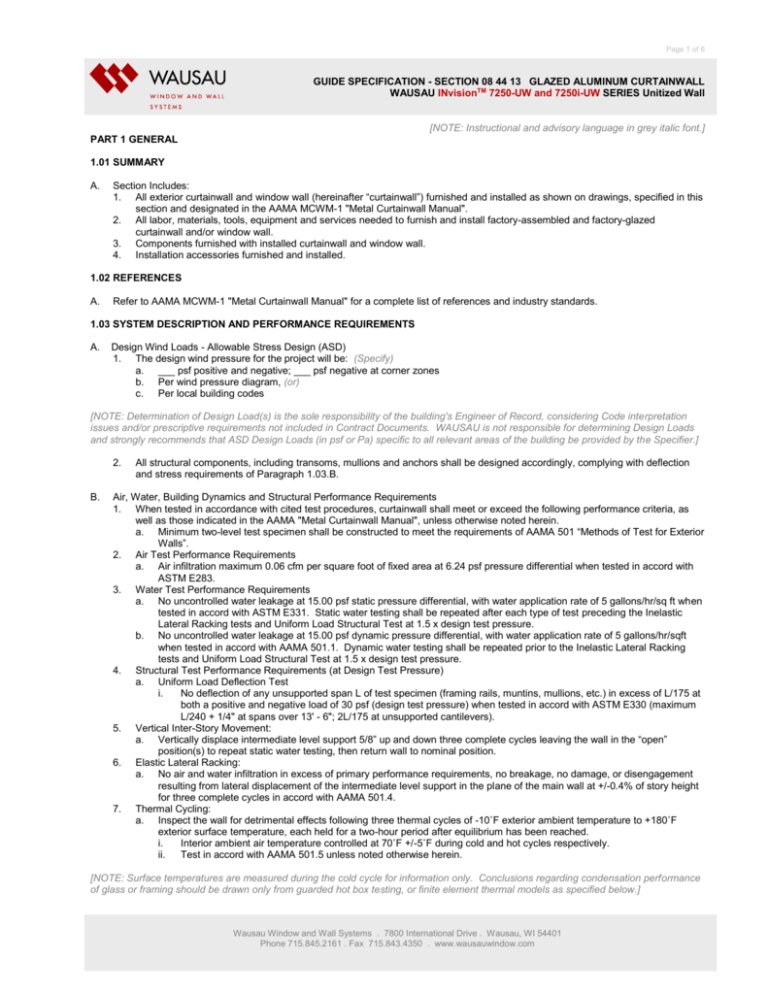
Page 1 of 6
GUIDE SPECIFICATION - SECTION 08 44 13 GLAZED ALUMINUM CURTAINWALL
WAUSAU INvisionTM 7250-UW and 7250i-UW SERIES Unitized Wall
[NOTE: Instructional and advisory language in grey italic font.]
PART 1 GENERAL
1.01 SUMMARY
A.
Section Includes:
1. All exterior curtainwall and window wall (hereinafter “curtainwall”) furnished and installed as shown on drawings, specified in this
section and designated in the AAMA MCWM-1 "Metal Curtainwall Manual".
2. All labor, materials, tools, equipment and services needed to furnish and install factory-assembled and factory-glazed
curtainwall and/or window wall.
3. Components furnished with installed curtainwall and window wall.
4. Installation accessories furnished and installed.
1.02 REFERENCES
A.
Refer to AAMA MCWM-1 "Metal Curtainwall Manual" for a complete list of references and industry standards.
1.03 SYSTEM DESCRIPTION AND PERFORMANCE REQUIREMENTS
A.
Design Wind Loads - Allowable Stress Design (ASD)
1. The design wind pressure for the project will be: (Specify)
a. ___ psf positive and negative; ___ psf negative at corner zones
b. Per wind pressure diagram, (or)
c. Per local building codes
[NOTE: Determination of Design Load(s) is the sole responsibility of the building's Engineer of Record, considering Code interpretation
issues and/or prescriptive requirements not included in Contract Documents. WAUSAU is not responsible for determining Design Loads
and strongly recommends that ASD Design Loads (in psf or Pa) specific to all relevant areas of the building be provided by the Specifier.]
2.
B.
All structural components, including transoms, mullions and anchors shall be designed accordingly, complying with deflection
and stress requirements of Paragraph 1.03.B.
Air, Water, Building Dynamics and Structural Performance Requirements
1. When tested in accordance with cited test procedures, curtainwall shall meet or exceed the following performance criteria, as
well as those indicated in the AAMA "Metal Curtainwall Manual", unless otherwise noted herein.
a. Minimum two-level test specimen shall be constructed to meet the requirements of AAMA 501 “Methods of Test for Exterior
Walls”.
2. Air Test Performance Requirements
a. Air infiltration maximum 0.06 cfm per square foot of fixed area at 6.24 psf pressure differential when tested in accord with
ASTM E283.
3. Water Test Performance Requirements
a. No uncontrolled water leakage at 15.00 psf static pressure differential, with water application rate of 5 gallons/hr/sq ft when
tested in accord with ASTM E331. Static water testing shall be repeated after each type of test preceding the Inelastic
Lateral Racking tests and Uniform Load Structural Test at 1.5 x design test pressure.
b. No uncontrolled water leakage at 15.00 psf dynamic pressure differential, with water application rate of 5 gallons/hr/sqft
when tested in accord with AAMA 501.1. Dynamic water testing shall be repeated prior to the Inelastic Lateral Racking
tests and Uniform Load Structural Test at 1.5 x design test pressure.
4. Structural Test Performance Requirements (at Design Test Pressure)
a. Uniform Load Deflection Test
i.
No deflection of any unsupported span L of test specimen (framing rails, muntins, mullions, etc.) in excess of L/175 at
both a positive and negative load of 30 psf (design test pressure) when tested in accord with ASTM E330 (maximum
L/240 + 1/4" at spans over 13' - 6"; 2L/175 at unsupported cantilevers).
5. Vertical Inter-Story Movement:
a. Vertically displace intermediate level support 5/8” up and down three complete cycles leaving the wall in the “open”
position(s) to repeat static water testing, then return wall to nominal position.
6. Elastic Lateral Racking:
a. No air and water infiltration in excess of primary performance requirements, no breakage, no damage, or disengagement
resulting from lateral displacement of the intermediate level support in the plane of the main wall at +/-0.4% of story height
for three complete cycles in accord with AAMA 501.4.
7. Thermal Cycling:
a. Inspect the wall for detrimental effects following three thermal cycles of -10˚F exterior ambient temperature to +180˚F
exterior surface temperature, each held for a two-hour period after equilibrium has been reached.
i.
Interior ambient air temperature controlled at 70˚F +/-5˚F during cold and hot cycles respectively.
ii.
Test in accord with AAMA 501.5 unless noted otherwise herein.
[NOTE: Surface temperatures are measured during the cold cycle for information only. Conclusions regarding condensation performance
of glass or framing should be drawn only from guarded hot box testing, or finite element thermal models as specified below.]
Wausau Window and Wall Systems . 7800 International Drive . Wausau, WI 54401
Phone 715.845.2161 . Fax 715.843.4350 . www.wausauwindow.com
Page 2 of 6
8.
9.
Inelastic Lateral Racking – In Plane of Wall:
a. No glass breakage, framing member or trim disengagement, catastrophic failure or “fall-out” resulting from lateral
displacement of the intermediate level support in the plane of the main wall at +/- 0.9% of story height for three complete
cycles in accord with AAMA 501.4.
Structural Test Performance Requirements (at 1.5 x Design Test Pressure)
a. Uniform Load Structural Test
i.
Specimen to be tested at 1.5 x design test pressure, both positive and negative, acting normal to plane of wall in
accord with ASTM E330.
ii.
No glass breakage; permanent damage to fasteners, hardware parts, or anchors; damage to make curtainwall insert
vents inoperable; or permanent deformation of any main frame member in excess of 0.2% of its clear span.
C. Condensation Resistance and Thermal Transmittance Performance Requirements
(Wausau recommends specifying U-Factor and SHGC requirements by citing the values used in the default, prescriptive or performance
compliance path option employed during permitting. Performance of specific frame-glass combinations in this Wausau product family can
be obtained from the NFRC Certified Products Directory, an NFRC CMA Bid Certificate, or an AAMA 507 report. Coordinate with 08 80 00
Glazing.)
1.
Perform thermal tests in accordance with NFRC 102 and/or AAMA 1503, or provide finite element computer thermal modeling
and calculations per NFRC 100, NFRC 705 or AAMA 507, using DOE/LBL THERM, WINDOW, and/or CMAST software.
a.
Thermal Transmittance (U-Factor) for the overall window area shall be less than or equal to _____ BTU/hr-ft2-F.
b.
Solar Heat Gain Coefficient (SHGC) for the overall window area shall not exceed ____.
c.
Condensation Resistance Factor (CRF) requirements: CRF minimum ___ (Frame) and CRF minimum ___ (Glass).
(Visit www.aamanet.org to access the AAMA online CRF Selection Tool. CRF varies with configuration, frame depth, and glass type.
Contact WAUSAU for CRF test data on specific frame-glass combinations in this product family.)
[DISCLAIMER: Condensation on interior surfaces of installed windows may be affected by many variables, including, but not limited to,
component thermal performance, thermal mass of surrounding materials, interior trim coverage and air flow conditions, weather and
mechanical system design. Since many of these variables are outside of our control, WAUSAU makes no representations or warranties
against the formation of condensation. Testing is conducted on pre-defined configurations under controlled and steady-state laboratory
conditions, as specified above.]
D. Acoustic Performance Requirements
2. Perform acoustical tests in accordance with ASTM E90 and ASTM E1425 on the glass type(s) specified in 08 80 00, rigidly
supported in aluminum framing of the same product type.
3. “Glass-only” test results shall not be acceptable.
4. Sound Transmission Class (STC) shall not be less than ___. (Specify STC 31 for 1” insulating glass with makeup of ¼” glass –
½” air space – ¼” glass. Coordinate with 08 80 00 Glazing.)
5. Outdoor-Indoor Transmission Class (OITC) shall not be less than ____. (Specify OITC 25 for 1” insulating glass with makeup of
¼” glass – ½” air space – ¼” glass. Coordinate with 08 80 00 Glazing.)
E. Sustainable Design Requirements
1. The products provided under this section may affect LEED® certification for the project. Provide documentation in accordance
with the applicable version of USGBC’s “LEED® for New Construction and Major Renovation,” verifying that the components,
processes and/or assemblies specified herein conform to the following requirements. (Select only those Credits needed for the
level of certification sought. Modify criteria as necessary for LEED® programs or versions applicable to specific projects.)
a. EA Optimize Energy Performance
i.
Area-weighted overall U-Factor not to exceed that specified in 1.03.
ii.
Area-weighted overall SHGC less than or equal to that specified in 1.03.
b. EA On-Site Renewable Energy
i.
Design framing to accept façade-integrated PV modules and associated NEC-compliant wiring where shown on
drawings.
ii.
Obtain UL 1703 listing for laminate support.
c. MR Recycled Content
i.
Provide curtainwall assemblies (aluminum framing, glass and other components) containing no less than ___%
(Specify up to 15%) combined recycled content by assembly weight.
ii.
Combined content to be calculated as post-consumer plus one-half pre-consumer recycled content by weight.
iii. Report pre- and post-consumer recycled content separately.
iv. All recycled secondary aluminum billet must meet Aluminum Association content requirements for the alloy used.
[NOTE: Secondary aluminum billet contains a high percentage of pre-consumer recycled content, however, glass comprises the majority
of the weight of a glazed curtainwall assembly.]
d.
e.
EQ Increased Ventilation
i.
Provide operable windows with occupant-enabled hardware.
ii.
Window sizes and configurations as shown on drawings.
EQ Low-Emitting Materials – Adhesives and Sealants
i.
All interior primers, structural glazing adhesives and metal-to-metal sealants used on site must meet applicable South
Coast Air Quality Management District (SCAQMD) Rule #1168 VOC limits.
Wausau Window and Wall Systems . 7800 International Drive . Wausau, WI 54401
Phone 715.845.2161 . Fax 715.843.4350 . www.wausauwindow.com
Page 3 of 6
f.
g.
h.
EQ Controllability of Systems
i.
Provide operable windows with occupant-enabled hardware.
ii.
Window sizes and configurations as shown on drawings.
EQ Thermal Comfort- Design
i.
Provide thermally-improved or thermal barrier framing and insulating glass edge construction as specified herein and
in 08 80 00 Glazing.
EQ Daylight and Views
i.
Area-weighted overall VT not less than 0.____ (Specify – Coordinate with 08 80 00 Glazing) per NFRC 200.
ii.
Curtainwall sizes and configurations as shown on drawings.
1.04 SUBMITTALS
A.
General Requirements
1. Provide all submittals in a timely manner to meet the required construction completion schedule.
B.
Shop Drawings
1. Shop drawings must be prepared wholly by the curtainwall manufacturer, or a qualified engineering services firm under the
guidance of the manufacturer. Shop drawings for pre-engineered configurations may be prepared by installers upon written
manufacturer consent.
2. Provide design details along with bid proposals to define system aesthetic and functional characteristics.
3. Provide up to three photocopied sets of shop drawings, including half size details of all necessary conditions.
C.
Samples
1. Components: Submit samples of anchors, fasteners, hardware, assembled corner sections and other materials and
components as requested by Architect.
2. Finish: Submit color samples for Architect's approval as requested.
D.
Test Reports and Calculations
1. Submit certified independent laboratory test reports verifying compliance with all test requirements of 1.03.
2. Submit structural calculations indicating adequacy of all materials furnished under this section, in meeting the uniform and
structural load requirements as specified in 1.03A.
1.05 QUALITY ASSURANCE
A.
Qualifications: Upon request, the curtainwall manufacturer shall provide written consent for the installation subcontractor to install
curtainwall products to be used on this project.
1.06 DELIVERY, STORAGE AND HANDLING
A.
Packing, Shipping, Handling and Unloading
1. Materials will be packed, loaded, shipped, unloaded, stored and protected in accordance with AAMA CW-10.
1.07 WARRANTY
A.
Aluminum Curtainwall Warranty
1. Products: Submit a written warranty, executed by the curtainwall manufacturer, for a period of ___ (up to 10) years from the
date of manufacture, against defective materials or workmanship, including substantial non-compliance with applicable
specification requirements and industry standards, which result in premature failure of the curtainwall, finish, factory-glazed
glass, or parts, outside of normal wear.
[NOTE: Refer to the WAUSAU Standard Limited Warranty for detailed exclusions, qualifications and limitations.]
2.
3.
In the event that curtainwall or components are found defective, manufacturer will repair or provide replacement material without
charge at manufacturer’s option.
Warranty for all components must be direct from the manufacturer (non pass-through) and non pro-rated for the entire term.
Warranty must be assignable to the non-residential owner, and transferable to subsequent owners through its length.
PART 2 PRODUCTS
2.01 MANUFACTURERS
A.
Acceptable Manufacturer
1. Drawings and specification are based on:
a. Wausau Window and Wall Systems – (Select one) 7250i-UW Thermal (or 7250-UW Thermally-Improved Series Unitized
Curtainwall and Window Wall.
b. Base bid will be Wausau Window and Wall Systems.
2. Substitutions
a. Other manufacturers’ products that meet or exceed specified design requirements may be considered. Submit the
following information with request for substitutions at least ten (10) working days prior to bid date.
i.
Test reports specified in 1.03.
ii.
Full proposal details and samples specified in 1.04.
iii. Copy of manufacturer's warranty specified in 1.07.
iv. Proof of at least 10 years experience in the design and fabrication of unitized curtainwall.
Wausau Window and Wall Systems . 7800 International Drive . Wausau, WI 54401
Phone 715.845.2161 . Fax 715.843.4350 . www.wausauwindow.com
Page 4 of 6
3.
4.
v. Other information as requested for evaluation
Substitute products not pre-approved by the Architect via addenda will not be considered.
Clear preference will be given to products produced in LEED®-certified manufacturing facilities.
2.02 MATERIALS
A.
Aluminum Framing Members
1. Extruded aluminum billet, 6063-T5 or T6 alloy for primary non-radius components; 6063-T5 or T6, 6005-T5, 6105-T5 or 6061-T6
for anchor components; all meeting the requirements of ASTM B221.
2. Aluminum sheet alloy 5005-H32 (for anodic finishing), or alloy 3003-H14 (for painted or unfinished sheet) meeting the
requirements of ASTM B209.
3. Principal extruded framing members will be a minimum 0.125" in thickness.
4. Extruded or formed trim components will be a minimum 0.060" in thickness.
5. System depth 7 ¼” with standard 1" glass setback.
6. Exterior face dimension 3" at vertical mullions.
7. Vertical mullions to be fully captured and/or structural glazed as indicated on architectural drawings.
8. Horizontal intermediate framing members to be fully captured and/or structural glazed as indicated on architectural drawings.
2.03 COMPONENTS
A.
Sealants
1. All sealants shall comply with applicable provisions of AAMA 800 and/or Federal Specifications FS-TT-001 and 002 Series.
2. Frame joinery sealants shall be suitable for application specified and as tested and approved by curtainwall manufacturer.
B.
Glass
1. Provide in accordance with Section 08 80 00.
2. Sealed insulated glass shall be tested and certified in accord with ASTM E2190.
C.
Glazing
1. Provide in general accordance with Section 08 80 00.
2. Glazing method shall be in general accordance with the GANA Glazing Manual for specified glass type, or as approved by the
glass fabricator.
D.
Glazing Materials
1. Setting Blocks/Edge Blocking: Provide in sizes and locations recommended by GANA Glazing Manual. Setting blocks used in
conjunction with soft-coat low-e glass shall be silicone.
2. Back-bedding tapes, expanded cellular glazing tapes, toe beads, heel beads and cap beads shall meet the requirements of
applicable specifications cited in AAMA 800.
3. Glazing gaskets shall be non-shrinking, weather-resistant, and compatible with all materials in contact.
4. Structural silicone sealant where used shall meet the requirements of ASTM C1184.
5. All materials and finishes in contact with structural silicone shall be tested for compatibility and approved by the sealant
manufacturer for the intended application.
6. Gaskets in continuous contact with structural silicone shall be extruded silicone or compatible material.
E.
Perimeter Fire Barrier System
1. Components of the perimeter fire barrier system included in the work of this section must be securely installed in accordance
with applicable ASTM E2307 or ASTM E119 tests.
[NOTE: The perimeter fire barrier system is composed of the exterior wall/spandrel panel, the floor assembly and the perimeter joint
protection installed in the linear opening/void between them, and is intended to prevent the passage of flame for the time period at least
equal to fire-resistance rating of the floor assembly. Engineering judgments per the International Firestop Council (IFC) “Recommended
IFC Guidelines For Evaluating Firestop Systems in Engineering Judgments (EJ’s)” necessary to address differences in materials or
methods between tested systems and systems to be installed must be provided by the party responsible for the entire perimeter fire
barrier system.]
F.
Steel Components
1. Provide steel reinforcements as necessary to meet the performance requirements of 1.03.
2. Concealed steel anchors and reinforcing shall be factory painted after fabrication with TGIC powder coating, or rust-inhibitive
primer complying with Federal Specification TT-P-645B.
G.
Receptors: (Optional)
1. Provide extruded aluminum receptors to receive window wall, as shown on architectural drawings.
2. Finish to match window wall frames.
H.
Dual Glazed Access Panel: (Optional)
1. Hinged (lift-off) access panel (Select one) provided with Allen locks for custodial operation.
2. Finish to match curtainwall frames.
I.
Integral Venetian Blinds: (Optional)
1. 5/8" or 1” wide (Select) aluminum slat blinds. Blind color shall be _____________. (Specify from standard color chart.)
2. Blind to be integrally mounted between the dual or triple glazing.
3. Tilt-control knob will be located on the interior face and incorporate a "slip clutch" feature.
Wausau Window and Wall Systems . 7800 International Drive . Wausau, WI 54401
Phone 715.845.2161 . Fax 715.843.4350 . www.wausauwindow.com
Page 5 of 6
4.
J.
Raise and lower pull cords will be located between glass for access only when glazed access panel is opened.
Curtainwall Insert Vents: (Optional)
1. Provide “zero sightline” projected curtainwall insert vents complying with the requirements of Section 08 51 13, at the locations
indicated on architectural drawings.
2.04 FABRICATION
A.
General Design and Fabrication Requirements
1. Finish, fabricate and factory-glaze unitized curtainwall and window wall under the responsibility of one manufacturer, with units
sized for ease of shipping, distribution and erection.
a. Systems using individual field fabricated or field assembled members are not acceptable.
2. Framing to be designed for glazing from the exterior.
3. Provide interlocking male/female type vertical mullion "stack" joints at adjacent grid frame members with sharp, well-defined
corners and flush sightlines.
4. Conceal fasteners at vertical to horizontal main framing connections and at miscellaneous trim except as shown on architectural
drawings or otherwise required.
5. Fabricate to allow for thermal movement of materials when subjected to a temperature differential from –10F exterior ambient
temperature to +180F exterior surface temperature without damage.
6. The curtainwall and window wall system shall be designed to accommodate a total of plus or minus 5/8" inter-story vertical
movement, including fabrication tolerance, without damage. Vertical movement shall be accommodated using interlocking
horizontal framing members.
7. Curtainwall and window wall anchorage shall provide for adjustment in the three orthogonal directions of a magnitude as predetermined by the Building Structural Engineer, but no less than 1" nominal.
8. The curtainwall system and its anchorage shall be designed to accommodate an elastic lateral drift of 0.4% of story height, and
inelastic drift of 0.9% of story height.
[Contact the WAUSAU Structural Engineering Department if lateral drift is expected to exceed the magnitude noted above.]
9.
System to be fully pressure-equalized at the interior plane of the glazing pocket with anchor penetrations and framing
connection fasteners located inboard of the primary air seal.
a. Provide a rain screen at all weeps to the exterior.
b. Provide vertical compartmentalization at no more than every two floors in height.
c. Provide continuous pressure-equalized and drained sill starters at the curtainwall base.
B.
Glass Drainage
1. Provide weep holes and/or drainage slots within glazing pockets to drain any condensation or accumulating water within the
system to exterior.
C.
"Snap-On" Covers and Exterior Glazing Beads
1. Snap-on covers and glazing beads applied to exterior frame glazing legs to show a sharp, uninterrupted exterior profile between
expansion joints.
2. Allow for horizontal thermal expansion and installation tolerance, as well as for vertical inter-story movement in cover and bead
joinery.
D.
Dual Glazed Access Panel (Optional)
1. Hinged (or lift-off) access panel (Select one) will be constructed with mitered corners, mechanically staked over a solid
aluminum corner block leaving hairline joinery.
E.
(Select one) Two-Level Thermal Break (or Thermally-Improved) Construction:
1. (7250i-UW only) Continuous extruded 6/6 polyamide nylon with 25% glass fiber reinforcing, mechanically crimped into crossknurled cavities.
a. Minimum thermal separation 3/8" at main framing.
b. Quality assurance records must be maintained and available as requested.
2. Frame and exterior snap-on covers shall be provided with nominal thermal separation using EPDM, cPVC or polyamide thermal
clips.
F.
Weather-Stripping
1. Dual durometer PVC, polypropylene, TPE, EPDM, neoprene, silicone, or other suitable material as tested and approved by the
curtainwall manufacturer.
2. Weather-stripping installed in integral dovetail races in framing members.
3. One row of fin-type weather-strip at interlocking vertical mullion members to provide isolation for horizontal movement.
4. One row of extruded bulb weather-strip at mullions to provide a pressure equalization seal under conditions of maximum
horizontal movement.
5. One row of extruded multi-fin weather-strip at interlocking horizontal frame members, to provide a pressure equalization seal
under conditions of maximum vertical movement.
a. Maintain compression using a rigid PVC bearing rod or other suitable means.
2.05 FINISHES
A.
Finish of Aluminum Components
1. Finish of all exposed areas of aluminum curtainwall and window wall components shall be done in accord with the appropriate
AAMA Voluntary Guide Specification shown (Select from below).
Wausau Window and Wall Systems . 7800 International Drive . Wausau, WI 54401
Phone 715.845.2161 . Fax 715.843.4350 . www.wausauwindow.com
Page 6 of 6
Designation
Description
Standard
Color
AAM10C21A41
Clear Class I
Eco-friendly etch
AAMA 611
Clear
AAM10C21A44
Electrolytically
Deposited Class I
Eco-friendly etch
AAMA 611
Champagne, Light Bronze, Medium Bronze
Dark Bronze, Extra Dark Bronze, Black
Interior Paint
50% PVDF,
Enamel, Acrylic
or Polyester
AAMA 2603
____________ (As selected by Architect)
Suitable for INTERIOR finishes
Exterior Paint
70% PVDF
AAMA 2605
____________ (As selected by Architect)
Suitable for INTERIOR or EXTERIOR finishes
[NOTE: For detailed specifications of other surface treatments and finishes available, as well as sustainable finishing process specification
upgrades contact Linetec or Wausau Window and Wall Systems. Color selection is recommended, for the most competitive bids.]
PART 3 EXECUTION
3.01 EXAMINATION
A.
Site Verification of Conditions
1. Verify that building substrates permit installation of curtainwall according to the manufacturer's instructions, approved shop
drawings, calculations and contract documents.
2. Do not install curtainwall until unsatisfactory conditions are corrected.
3.02 INSTALLATION
A.
Erection of Aluminum Curtainwall
1. Install curtainwall with skilled workers in accordance with approved shop drawings, installation instructions, specifications, and
the AAMA MCWM-1 "Metal Curtainwall Manual".
2. Curtainwall must be installed plumb, square and level for proper weathering and operation.
3. Aluminum that is not organically coated shall be insulated from direct contact with steel, masonry, concrete or other dissimilar
metals by bituminous paint, rust-inhibiting primer, non-conductive shims or other suitable insulating material.
[DISCLAIMER: Wausau Window and Wall Systems takes no responsibility for product selection or application, including, but not limited
to, compliance with building codes, safety codes, laws, merchantability or fitness for a particular purpose; and further disclaims all liability
for the use, in whole or in part, of these Guide Specifications in preparation of project specifications and/or other documents. Guide
Specifications are subject to change at any time, without notice, and at Wausau’s sole discretion.]
“INvision” is a trademark of Apogee Wausau Group, Inc. All rights reserved. ©2014 Apogee Wausau Group, Inc.
Wausau Window and Wall Systems . 7800 International Drive . Wausau, WI 54401
Phone 715.845.2161 . Fax 715.843.4350 . www.wausauwindow.com

